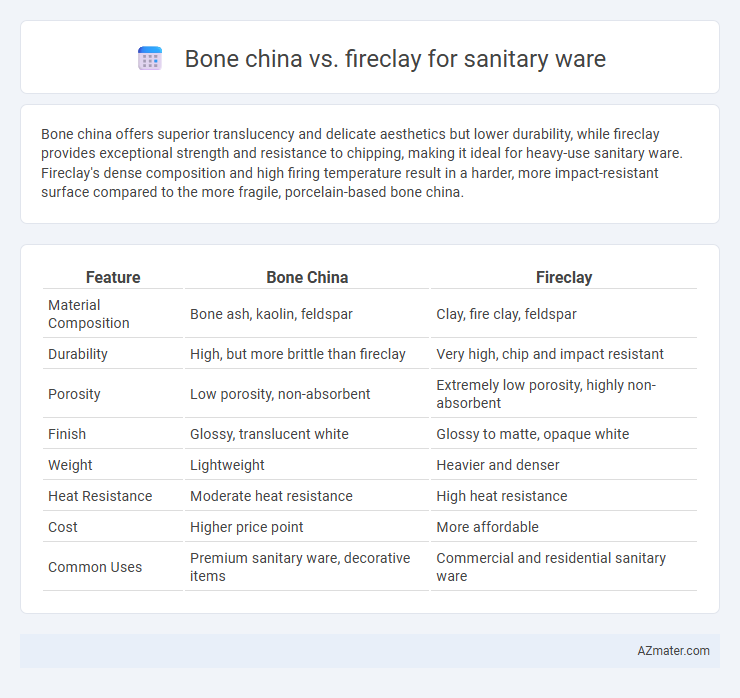Bone china offers superior translucency and delicate aesthetics but lower durability, while fireclay provides exceptional strength and resistance to chipping, making it ideal for heavy-use sanitary ware. Fireclay's dense composition and high firing temperature result in a harder, more impact-resistant surface compared to the more fragile, porcelain-based bone china.
Table of Comparison
| Feature | Bone China | Fireclay |
|---|---|---|
| Material Composition | Bone ash, kaolin, feldspar | Clay, fire clay, feldspar |
| Durability | High, but more brittle than fireclay | Very high, chip and impact resistant |
| Porosity | Low porosity, non-absorbent | Extremely low porosity, highly non-absorbent |
| Finish | Glossy, translucent white | Glossy to matte, opaque white |
| Weight | Lightweight | Heavier and denser |
| Heat Resistance | Moderate heat resistance | High heat resistance |
| Cost | Higher price point | More affordable |
| Common Uses | Premium sanitary ware, decorative items | Commercial and residential sanitary ware |
Introduction to Bone China and Fireclay in Sanitary Ware
Bone china in sanitary ware is a type of ceramic known for its high strength, translucency, and smooth, non-porous surface, achieved by mixing bone ash with kaolin and feldspar. Fireclay sanitary ware is made from a dense, refractory clay fired at high temperatures, resulting in durability, resistance to chipping, and a matte finish. Both materials offer distinct advantages in bathroom fixtures, with bone china excelling in elegance and smoothness, while fireclay provides robustness and heat resistance.
Material Composition: Bone China vs Fireclay
Bone china consists primarily of kaolin, feldspar, and approximately 25-50% bone ash, which provides a unique translucency, high strength, and chip resistance ideal for sanitary ware. Fireclay is composed mainly of refractory clays with a high alumina content, offering exceptional thermal shock resistance and durability but less translucency than bone china. The distinct material composition influences the performance, aesthetic, and application suitability of bone china and fireclay sanitary ware products.
Manufacturing Process Differences
Bone china sanitary ware is produced by incorporating bone ash, kaolin, and feldspar, which results in a fine, translucent, and strong ceramic body formed through high-temperature firing around 1250-1300degC. Fireclay sanitary ware involves blending refractory clay with other raw materials and firing at even higher temperatures, typically 1200-1300degC, creating a dense, durable, and non-porous product with excellent resistance to thermal shock. The distinct raw materials and firing temperatures influence the final characteristics, with bone china offering smoother finishes and fireclay providing superior toughness and impact resistance.
Durability and Strength Comparison
Bone china, composed primarily of bone ash, offers excellent strength and chip resistance but is generally more fragile under heavy impact compared to fireclay. Fireclay sanitary ware, made from a dense mixture of clay and minerals, excels in durability, resisting scratching, chipping, and thermal shocks more effectively. For long-lasting performance in high-traffic bathrooms, fireclay is typically preferred due to its superior strength and robustness.
Water and Stain Resistance
Bone china exhibits moderate water absorption rates, typically below 0.5%, which enhances its resistance to water infiltration but makes it less effective against long-term staining compared to fireclay. Fireclay sanitary ware boasts a porous, vitrified surface with water absorption rates often under 0.1%, offering superior resistance to water and stains, preventing moisture penetration and minimizing discoloration. The denser composition of fireclay ceramics also contributes to increased durability and ease of maintenance in high-use bathroom environments.
Aesthetic Appeal and Design Options
Bone china offers a translucent, smooth finish with a delicate, luxurious aesthetic favored in high-end sanitary ware designs. Fireclay provides a robust, matte surface that supports a wider variety of shapes and textures, enhancing versatility in contemporary and rustic bathroom styles. The choice between bone china and fireclay depends on desired visual elegance versus durable, customizable design options in sanitary fixtures.
Cost Analysis: Bone China vs Fireclay
Bone china sanitary ware typically has a higher upfront cost due to its refined composition and manufacturing process, which involves high-temperature firing of kaolin, feldspar, and bone ash, resulting in a dense, translucent product. Fireclay sanitary ware, made from a mixture of clay fired at very high temperatures, offers a more affordable option with increased durability and resistance to chipping or cracking but may lack the delicate aesthetic appeal of bone china. When analyzing cost-effectiveness, fireclay provides better long-term value for high-traffic commercial settings, while bone china suits premium residential installations where luxury and finish quality justify the higher price.
Environmental Impact and Sustainability
Bone china sanitary ware offers a lower environmental footprint due to its long-lasting durability and reduced need for replacement, supporting sustainability through resource efficiency. Fireclay, made from natural clay materials and often fired at lower temperatures, presents benefits in energy consumption and recyclability, contributing to eco-friendly manufacturing processes. Both materials promote sustainability, but fireclay's minimal energy requirements and natural composition make it a particularly environmentally conscious choice for sanitary ware.
Maintenance and Cleaning Ease
Bone china sanitary ware offers a smooth, non-porous surface that resists stains and requires minimal cleaning effort, making it highly maintenance-friendly. Fireclay, while durable and heat-resistant, has a more porous texture that can trap dirt and requires more frequent scrubbing with non-abrasive cleaners to maintain its appearance. Both materials benefit from regular wiping with mild detergents, but bone china's glazing provides superior ease in daily upkeep and long-term stain prevention.
Choosing the Right Material for Your Bathroom
Bone china offers a smooth, glossy finish with high durability and stain resistance, making it ideal for premium bathroom fixtures that require an elegant appearance. Fireclay is a dense, non-porous ceramic known for its exceptional hardness and chip resistance, perfect for heavy-use sanitary ware like sinks and basins in high-traffic bathrooms. Selecting between bone china and fireclay depends on balancing aesthetic preference with practical durability needs to ensure long-lasting performance in your bathroom.

Infographic: Bone china vs Fireclay for Sanitary ware
 azmater.com
azmater.com